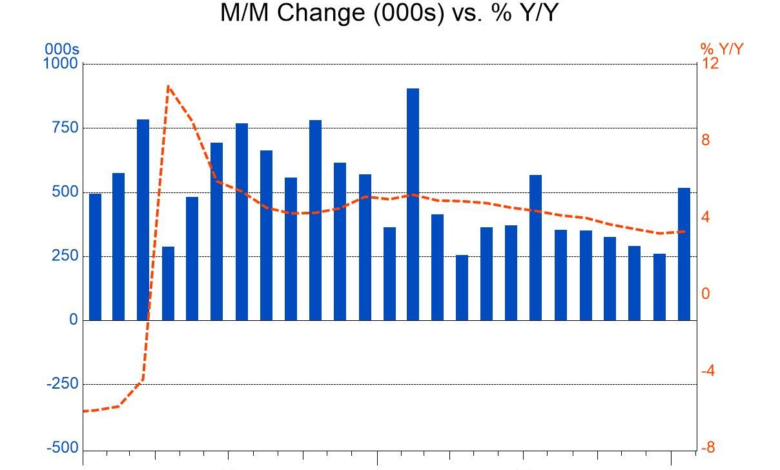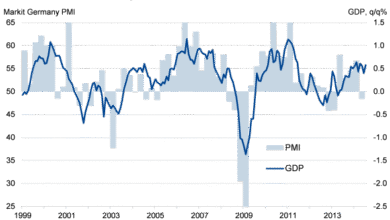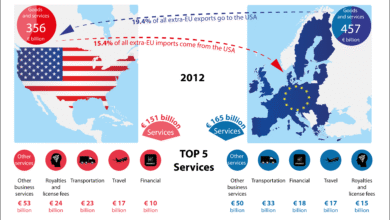U.S. Payroll Growth Exceeds Expectations in March 2025

U.S. payroll growth experienced a notable increase in March, with nonfarm payrolls rising by an impressive 228,000 jobs according to the latest jobs report from the Bureau of Labor Statistics. This remarkable figure exceeded the Dow Jones estimate of 140,000 and significantly improved from February’s revised total of 117,000, signaling a robust labor market. However, the accompanying unemployment rate rose to 4.2%, raising concerns amidst ongoing economic uncertainty. Health care job growth was particularly strong, with the sector adding 54,000 positions, aligning with its consistent performance over the past year. As average hourly earnings inched up by 0.3%, many analysts are taking a closer look at the implications of these trends in the context of potential job market shifts.
In evaluating recent developments in the American employment landscape, it’s essential to acknowledge the upward trend in employment levels reflected by U.S. payroll statistics. The March jobs report indicated a substantial increase in nonfarm employment figures, showcasing a resilient workforce despite fluctuations in the unemployment rate. Key sectors, such as health care, have demonstrated significant job creation, contributing to overall economic stability. Furthermore, the report included valuable insights about hourly wages and the broader implications of hiring trends, especially in light of external economic pressures, such as increasing tariffs and their potential impact on business growth. By analyzing these various components, we can gain a clearer understanding of how labor conditions are evolving in the current market.
U.S. Payroll Growth: A Closer Look at March’s Job Gains
In March, the U.S. payroll growth surged impressively with an addition of 228,000 jobs, highlighting a significant rebound from the previous month’s revised figures of 117,000. This strong growth not only surpassed the Dow Jones estimate of 140,000 but also reflects the resilience of the labor market amid ongoing economic challenges. According to the Bureau of Labor Statistics, this surge illustrates a robust labor force that continues to expand, despite uncertainties stemming from global trade tensions.
The health care sector emerged as a key player in this growth, adding 54,000 jobs, which closely aligns with the industry’s 12-month average. This indicates not only consistency but also the critical role that health care continues to play in the overall job market. Coupled with a slight increase in average hourly earnings of 0.3%, we see a labor market that is driving steadily forward, even in the face of economic fluctuations.
Impact of the Unemployment Rate Increase on Labor Market Trends
Despite the encouraging job growth, the unemployment rate rose to 4.2%, which was higher than the expected 4.1%. This increase can be attributed to a rising labor force participation rate, suggesting more individuals are entering the job market. Although more jobs were created, the uptick in unemployment requires a deeper analysis, as it may reflect underlying shifts in economic sentiment or seasonal job hiring.
The rise in the unemployment rate can also indicate a competitive labor market, where employers may be hesitant to hire amid uncertainty surrounding global tariffs and trade policies. The mixed signals from the jobs report illustrate that while job creation remains strong, the broader economic landscape might compel employers to think twice about expanding their workforce, leading to variations in hiring practices across different sectors.
Health Care Job Growth: Leading the Way in Employment
As the primary driver of job creation in March, health care services added a substantial 54,000 jobs, demonstrating sustained demand within the industry. This growth is crucial not only for individuals seeking employment but also for the economy, as health care consistently ranks among the top sectors for job stability and growth potential. The sector’s adaptability to technological advancements and patient needs contributes to its success in adding jobs, thereby enhancing the overall job market.
Moreover, the stability observed in health care job growth amidst other sectors grappling with volatility showcases its significance. This sustained increase underlines the importance of health care professionals and services, especially as the nation tends to focus on improving public health systems and infrastructure. As a result, health care remains a focal point for policymakers and job seekers alike.
Understanding Average Hourly Earnings Trends Amid Job Growth
In conjunction with the job growth figures, average hourly earnings experienced a 0.3% increase, which aligns with economic forecasts. This growth in average earnings is a positive indicator for workers, suggesting that as payrolls expand, employees may also enjoy higher wages, albeit at modest rates. The annual rate of 3.8%, while the lowest since July 2024, still indicates that wages are on the rise, which can enhance consumer spending and overall economic health.
However, the slight easing in the growth rate of average hourly earnings may raise questions about inflationary pressures and living costs. It signals that while employment may be increasing, the real wage growth for workers might not keep pace with inflation, impacting their purchasing power. Employers and economists alike will be watching these trends closely to gauge the potential impacts on economic growth.
March Jobs Report: An Overview of Labor Market Resilience
The March jobs report, detailed by the Bureau of Labor Statistics, presents a multifaceted look at the current state of the U.S. labor market. The addition of 228,000 jobs, surpassing expectations, alongside a rising unemployment rate to 4.2%, indicates a complex economic environment. While job creation remains promising, the concurrent rise in unemployment highlights the necessity for adapting strategies in workforce management and planning in response to changing economic conditions.
This report, issued on April 4, 2025, provides invaluable insights into labor trends that stakeholders must consider. Analysts and economic experts view the report as a critical snapshot of the labor landscape, especially since it follows significant political announcements regarding tariffs that could impact future hiring trends. Such reports are vital in shaping economic policies and employer strategies moving forward.
Evaluating Tariff Effects on Employment Growth and Projections
The recent announcements regarding tariffs by President Trump have raised concerns over potential impacts on U.S. employment growth. With fears of a global trade war looming, companies may adopt a cautious approach to hiring as they navigate these uncertain waters. The implications of these tariffs on various sectors highlight the interconnectedness of global trade and local employment, underscoring the need for businesses to strategize around potential economic shifts.
As labor market projections begin to reflect these concerns, analysts predict that sectors vulnerable to international trade could experience significant hiring slowdowns. While sectors like health care continue to thrive, others may not share the same resilience, urging employers to reassess their hiring plans under the backdrop of looming tariffs and potential retaliatory measures from trade partners.
Future Outlook: Navigating Employment Challenges and Opportunities
Looking ahead, the landscape for U.S. employment will remain dynamic, as both economic growth and external factors like tariffs influence job creation. Employers must remain adaptable, balancing between current employment levels and the potential for future growth in a climate of uncertainty. The March jobs report serves as a reminder of the resilience present within the U.S. labor market, yet it also raises caution flags about sustainability in the face of global economic challenges.
As businesses plan for the future, understanding the intricacies of current labor trends, including unemployment shifts and wage growth, will be paramount. Employers should not only focus on immediate hiring needs but also consider long-term strategies that account for macroeconomic trends, ensuring that their workforce remains effective and responsive to the changing demands of the economy.
Key Sectors Contributing to Job Growth: Insights and Analysis
The sectors driving job growth in March, particularly health care, retail, and social assistance, reveal valuable insights into economic trends. With health care leading the pack by adding 54,000 jobs, it’s evident that the demand for medical and support services continues to rise, reflecting demographic shifts and an increasing focus on healthcare quality and access. Retail and social assistance also played significant roles, showcasing a diversity of opportunities across different industries.
Understanding these growth sectors is essential for workforce development initiatives and training programs aimed at equipping individuals with relevant skills. As these sectors expand, targeted education and training programs will contribute significantly to future employment opportunities, helping to mitigate hiring challenges that may arise due to economic uncertainties.
Implications of Employment Data on Economic Policies and Strategies
The implications of the March job report extend beyond immediate employment statistics; they also influence economic policies and strategies. The mixed signals from the increased payroll figures and the uptick in the unemployment rate signal to policymakers the need for a nuanced approach to economic management. Ongoing monitoring and adjustment of fiscal and monetary policies will be critical in enhancing the labor market’s resilience.
In light of these revelations, government officials and economic advisors will likely engage in dialogue aimed at developing policies that foster job creation while addressing inflation concerns. Strategic interventions might include tax incentives for employers and support for industries that have shown robust job growth, helping to solidify the labor market’s strength against unpredictable global economic factors.
Frequently Asked Questions
What did the March jobs report reveal about U.S. payroll growth?
The March jobs report revealed that U.S. payrolls rose by 228,000, significantly surpassing the Dow Jones estimate of 140,000. This increase reflects strong U.S. payroll growth, particularly in the health care sector, which added 54,000 jobs, consistent with its average growth over the past year.
How did the unemployment rate change according to the latest payroll growth statistics?
According to the latest payroll growth statistics, the unemployment rate increased to 4.2%, surpassing the forecast of 4.1%. This rise occurred despite the overall positive U.S. payroll growth, indicating that more individuals are entering the labor force.
What sectors contributed to the U.S. payroll growth mentioned in the March jobs report?
The March jobs report highlighted that health care was a significant contributor to U.S. payroll growth, adding 54,000 jobs. Additionally, social assistance and retail also saw considerable job increases, adding 24,000 jobs each, while transportation and warehousing contributed 23,000 jobs.
How did average hourly earnings change in March in relation to payroll growth?
In March, average hourly earnings increased by 0.3%, consistent with forecasts and indicative of a steady labor market amid U.S. payroll growth. However, the annual growth rate of 3.8% was the lowest recorded since July 2024.
What does the Bureau of Labor Statistics report say about job additions in March?
The Bureau of Labor Statistics report for March indicates that nonfarm payrolls increased by 228,000, showcasing robust U.S. payroll growth despite a rising unemployment rate and the national economic uncertainty surrounding trade tariffs.
What does the increase in U.S. payroll growth suggest about the labor market’s stability?
The increase in U.S. payroll growth, with 228,000 jobs added in March, suggests some stability in the labor market, providing temporary reassurance despite the uptick in the unemployment rate and potential pressures from external economic factors like trade tariffs.
What trends were observed in job growth in comparison to prior months?
Job growth in March was stronger than in previous months, showing a rise from February’s revised increase of 117,000. This upward trend in U.S. payroll growth also marks a significant rebound above initial estimates, highlighting resilience in certain sectors despite external economic concerns.
What impact could current economic conditions have on future U.S. payroll growth?
Current economic conditions, including rising tariffs and trade tensions, may lead employers to be more cautious in their hiring practices, potentially affecting future U.S. payroll growth. As seen in the March jobs report, while payrolls increased, broader uncertainties could create challenges moving forward.
| Key Point | Details |
|---|---|
| Payroll Growth | U.S. payrolls rose by 228,000 in March, up from a revised 117,000 in February, exceeding predictions. |
| Unemployment Rate | The unemployment rate rose to 4.2%, higher than the forecast of 4.1%. |
| Industry Growth | Health care added 54,000 jobs in March, consistent with its 12-month average. |
| Average Hourly Earnings | Hourly earnings increased by 0.3% for March, but the annual growth of 3.8% is the lowest since July 2024. |
| Market Response | Minimal reaction from stocks; concerns remain due to tariff announcements and potential trade wars. |
| Future Outlook | While job growth indicates stability, ongoing tariff uncertainties may impact future hiring and economic performance. |
Summary
U.S. payroll growth demonstrated a notable increase in March, with 228,000 new jobs added, indicating a resilient labor market despite rising unemployment rates. While the growth surpasses expectations and continues a trend of job increases, the concurrent rise in the unemployment rate to 4.2% reflects emerging concerns linked to recent tariff announcements, suggesting that employers might approach future hiring with caution. Overall, the current data presents a mixed outlook for the U.S. economy as it navigates these challenges.




